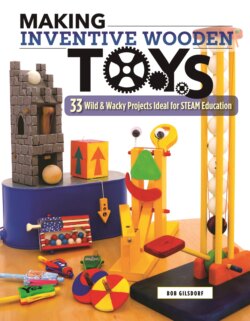Читать книгу Making Inventive Wooden Toys - Bob Gilsdorf - Страница 10
ОглавлениеGUMBALL AQUARIUM
A simple idea for a toy came to mind: to build a gumball machine that requires the would-be-bubble-blower to demonstrate a little ambidextrous skill before being rewarded with a sweet treat. Adding a little adversity between you and the gumball not only makes the toy more interactive and rewarding, but more importantly, cuts down on the number of gumball refills. Now, what type of epic challenge would be worthy of a tasty, colorful orb of endless chewing delight?
MATERIALS
• ¾" x 5 ½" x 31"
(2cm x 14cm x 79cm) pine board for top, bottom, and sides
• ⅛" x 7 ½" x 9 ½"
(3mm x 19cm x 24cm) clear acrylic plastic, 2 each
• ½" (13mm) dowel, 11 ¼" (29cm) long, for obstacles and grabbers
• ¼" (6mm) dowel, 12" (30cm) long, 2 each, for handles
• ¾" (2cm) ball, 2 each (optional)
• 8 – 1 ¼" (3cm) coarse-thread drywall screws
• 12 – #4, ⅜" (1cm) pan head screws
• Golf tee
• Gumballs (several thousand pounds, preferably unused)
TOOLS
• Coping saw
• Miter saw
• Miter box
• Drill with bits: 1" (2.5cm), ⅝" (1.5cm), ⅜" (1cm), ½" (13mm), ¼" (6mm), " (40mm), ⅛" (3mm), and counter sink
• Screwdriver
CHALLENGE 1
I never mastered chopsticks so I think using a chopstick in each hand to lift a gumball out of a box seems like an appropriately high level of difficulty.
CHALLENGE 2
As it turns out, lifting a gumball straight up with two chopsticks is rather easy. Let’s complicate this by making each chopstick move through a maze.
CHALLENGE 3
Why be nice? Let’s add some obstacles inside our box so you really have to work hard to get the gumball and literally taste success.
WIGGLE ROOM
We need a lot of maneuverability for the chopsticks, but the maze tracks can’t be too wide or the gumballs will fall out. By beveling the inside and outside edges of the maze we can now move the chopsticks in many directions.
CREATING THE PARTS
Cut the top, bottom, and sides to size. Make sure the sides are free of knots. For the bottom segment: all holes are drilled ½″ (13mm) deep; ″ (4mm) holes on the side are drilled through and countersunk on the bottom side; the ″ (4mm) hole in the center is ½″ (13mm) deep for the golf tee; the dashed holes are 1″ (2.5cm) in diameter and about ⅛″ (3mm) deep to capture gumballs; these holes are randomly located.
Cut the front and back from clear acrylic.
Attach the patterns to the sides and bottom (the patterns will be on the inside of the aquarium). Mark the hole locations on the top, front, and back.
HELPFUL HINT
Acrylic can be cut and drilled with standard woodworking tools. Just use lower speeds.
PUTTING IT ALL TOGETHER
THE FINISHED PRODUCT
The end result looks a lot like an aquarium, but instead of exotic, shimmering fish, the tank is full of beautiful, multicolored gumballs, all doing their best to escape capture. The seaweed was painted on the outside of the acrylic to make it look more like an aquarium.
